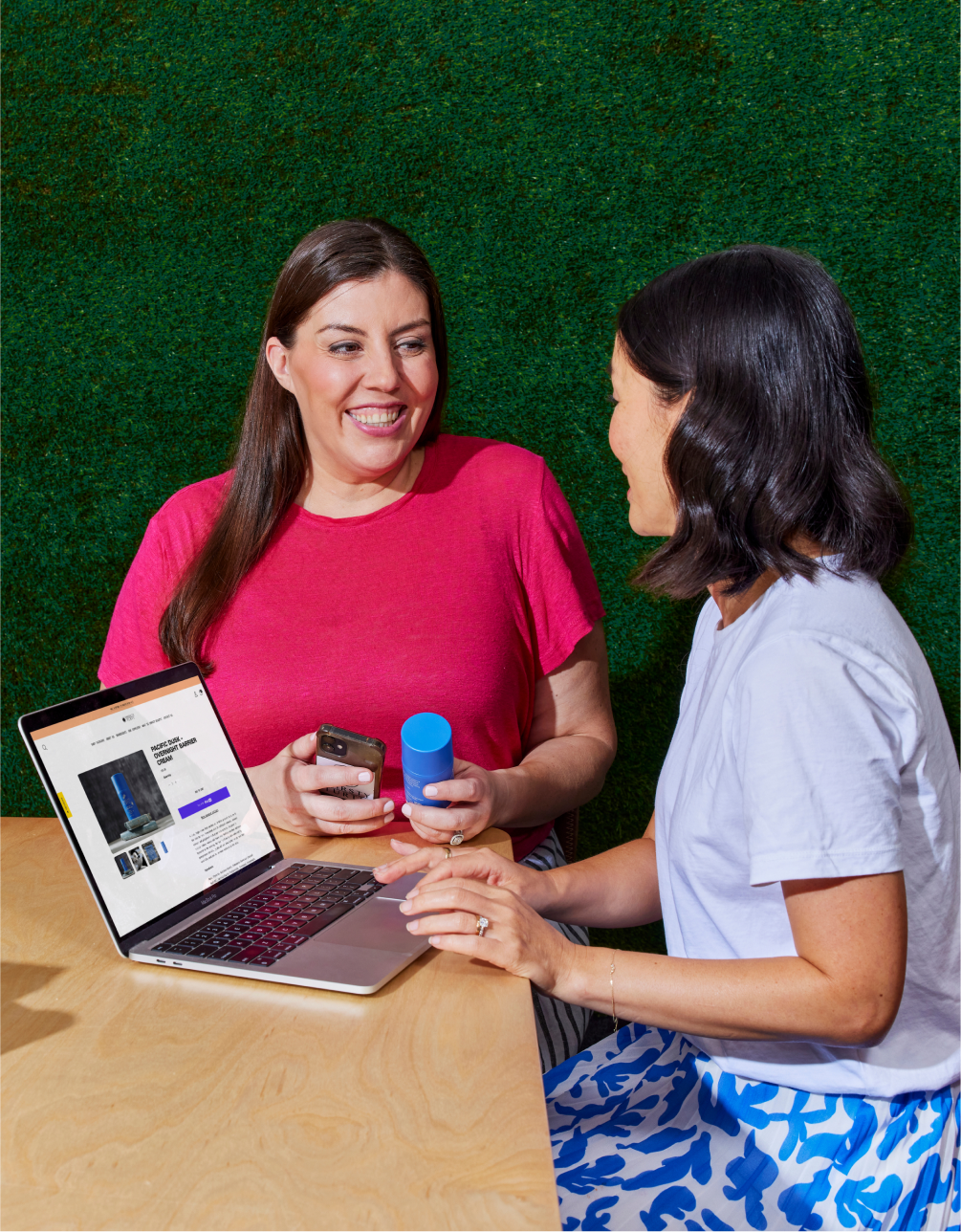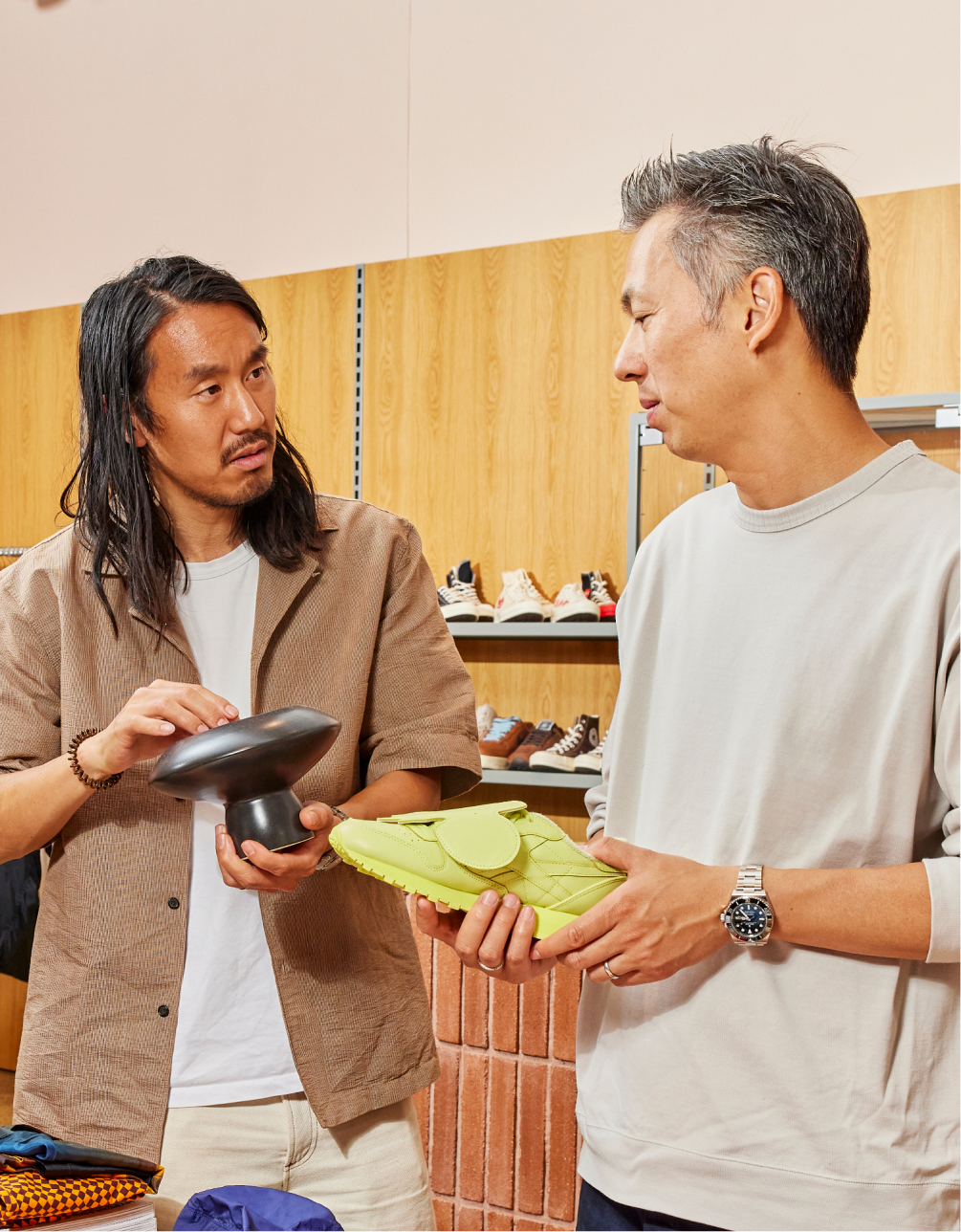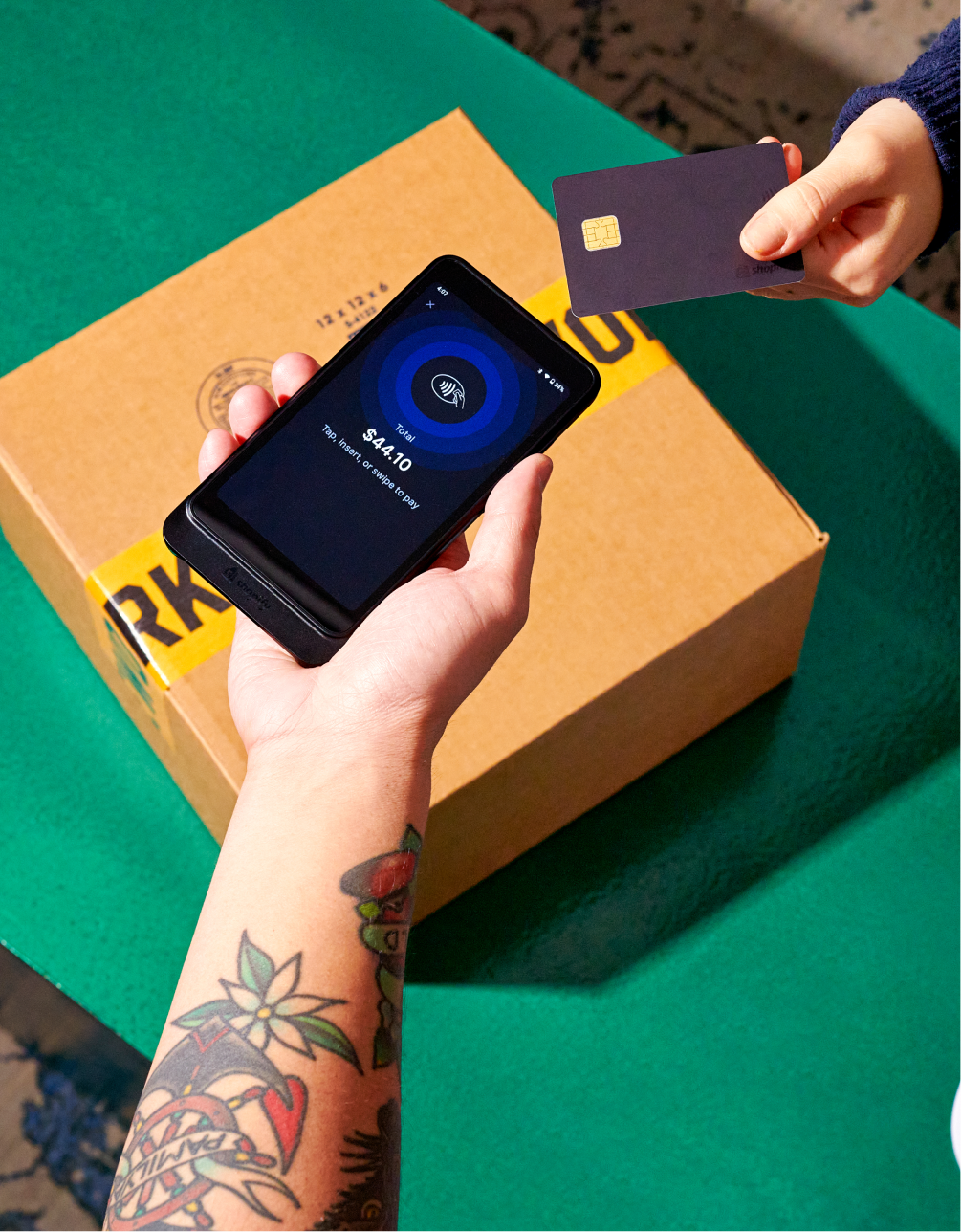The Holiday season is a prime time for advertising on Facebook. While higher competition means there’s often a steeper cost-per-click to pay, it can still be an ultra-rewarding time for ecommerce brands to advertise on the social media platform.
Plus in recent years, Black Friday has gone from being a Thanksgiving distraction to one of the most important dates in any ecommerce business’s calendar.
Google Trends shows a steady increase in search popularity for Black Friday over time—with the exception of a pandemic-related interruption.
Despite pandemic-related concerns around consumer spending cutbacks, Black Friday sales for ecommerce brands grew almost 16% in 2021, reaching $10.42 billion in the US alone.
So how can your brand tap into one of the most important days of the year for ecommerce sales?
Using Facebook Ads can be an effective way of converting more of your target audience. But to stand out in a sea of Black Friday ads, you’ll need to understand your target shopper and how to best reach them. Here’s our complete guide to Black Friday Facebook ads.
Why should you advertise during Black Friday?
Other than the increase in sales, brands will need to advertise if they want their Black Friday deals to stand out––organic Facebook campaigns are no longer enough to get in front of your target audience.
Buyers are actively looking to purchase
Price-savvy shoppers wait months for Black Friday to make high-ticket purchases. They’re online and ready to shop, so it makes sense for retailers to target them.
In 2021, 108 million US shoppers said they planned to shop on Black Friday (compared to 62.8 million intending to shop on Cyber Monday).
Plus, consumers are increasingly looking to shop for Black Friday deals online. In 2021, six out of 10 millennials intended to shop in-store, while three-quarters said they intended to shop online.
Brands looking to have a profitable Black Friday and Cyber Monday need to actively target these hungry shoppers with Facebook ads.
Holiday shopping equals a huge percentage of annual sales
Black Friday is the biggest day in the retail calendar for a reason––it makes up a large proportion of annual sales.
In the US, ecommerce sales on Black Friday reached $10.42 billion in a year when total ecommerce sales hit $919.06 billion––an average of 1.14% of annual sales. While that sounds like a small number, it’s still a lot for one day in the calendar year.
Different verticals and individual businesses may see better results depending on their customer base and products.
Opportunity to cross-sell and upsell stock
Black Friday is a great chance not only to move your bestsellers but also to shift some of those harder-to-sell products that have been sitting in your warehouse throughout the year. Brands can offer tempting discounts or bundle products together to make it easier to sell them.
In 2021, the majority (58%) of Black Friday purchases were impulse buys plus, and while there was an average 8% decrease in orders, there was a 9% increase in order values. This indicates that ecommerce brands had success in recommending other products. It also shows people are open to making unplanned purchases.
Use Black Friday as an opportunity to showcase your full range of products and consider cross-selling and upselling stock. This could be as simple as providing shoppers with a selection of recommended products or showcasing products at checkout.
For example, DTC cookware brand Great Jones upsells similar lower-priced goods when shoppers add products to their shopping baskets. This helps increase average order value and shift lower-value goods.
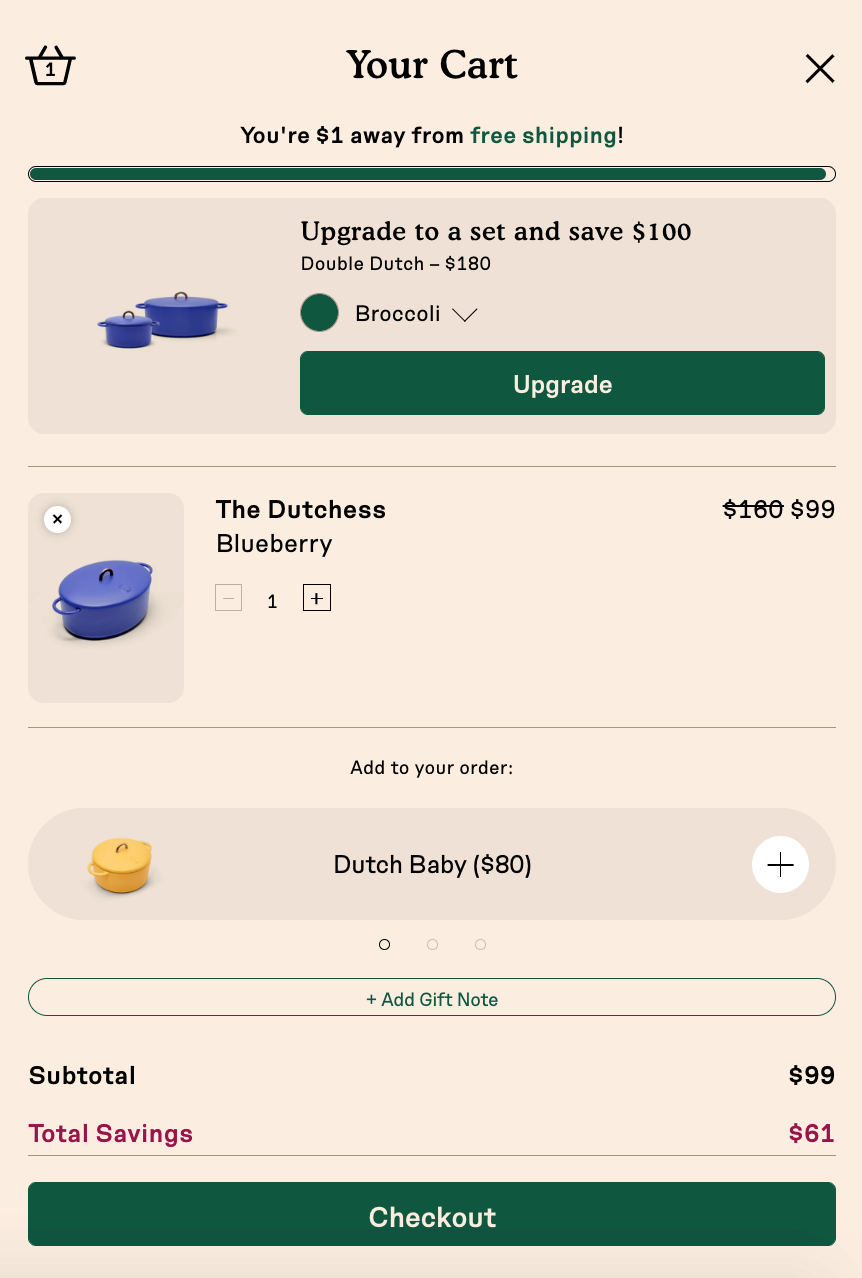
Advertise to new and existing audiences
Black Friday is an ideal moment to advertise to and convert new shoppers. In fact, in 2021, most shoppers on Black Friday were first-time buyers in all verticals.
People are open to purchasing from unfamiliar brands and making impulse buys. Tap into these preferences and use your Black Friday promos as a chance to reach new audiences.
6 tips for running successful Black Friday Facebook Ads
To achieve success with your Black Friday campaigns, you’ll need a solid advertising strategy in place. Here are six tips to get you started.
1. Start planning early
Planning ahead helps your brand get ahead of the competition. The key here is to put some budget aside to entice your target shoppers before the holiday shopping frenzy begins.
Bidding before Black Friday will be cheaper, you’ll save some of your ad budget, and you’ll have more chances to get in front of your target audience. This will also help you grow audiences for retargeting campaigns, which you can use on or after Black Friday.
By warming up your target audience before Black Friday, and then retargeting them later, you’ll see your ROAS increase too. Brands with larger budgets can start prospecting with ads as early as October.
Premium luggage brand The Shrine had already started using ads related to Black Friday in October.
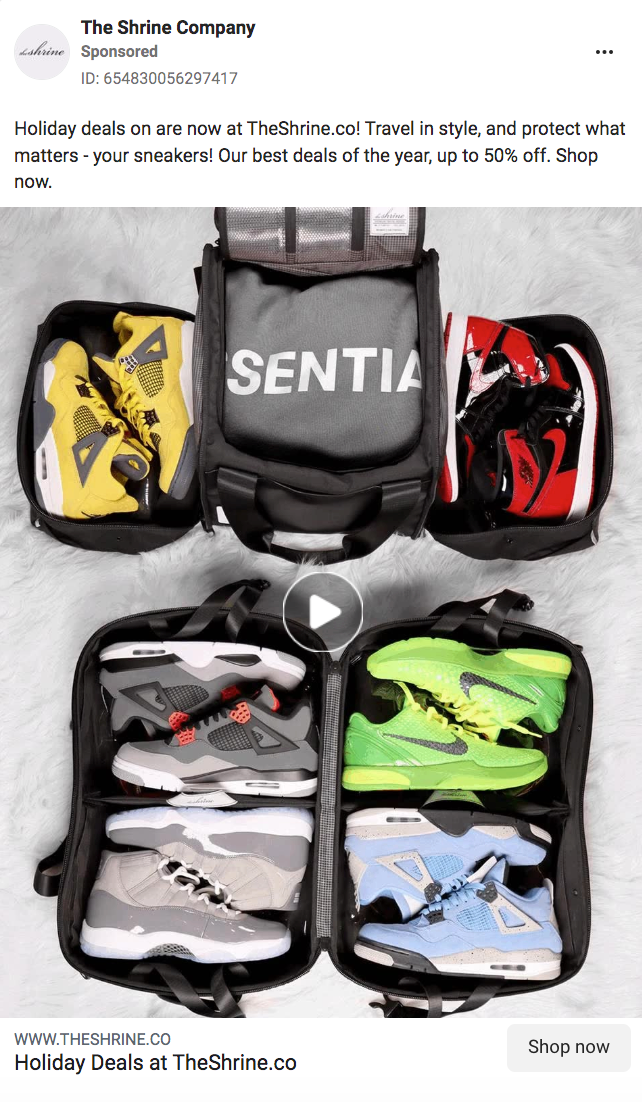
2. Refine your target audiences
You need to be in front of people most likely to find your offering relevant and make a purchase. For the best chance of success with your Black Friday campaigns, refine your target audiences.
Start by creating custom audiences from your brand’s email lists. Then, based on these groups, you can build lookalike audiences. These help you reach new customers who are similar to your existing ones.
This means you’ll reach people more likely to be interested in your offers and shoppers who may make impulse purchases.
The key is to make sure your Black Friday ads are targeted to select audiences. Without properly targeting ads to groups of audience demographics, you risk burning through your campaign budget with little to no results.
For example, The Record Hub made sure its audience was set to people in Ireland due to the location of the store's flagship.
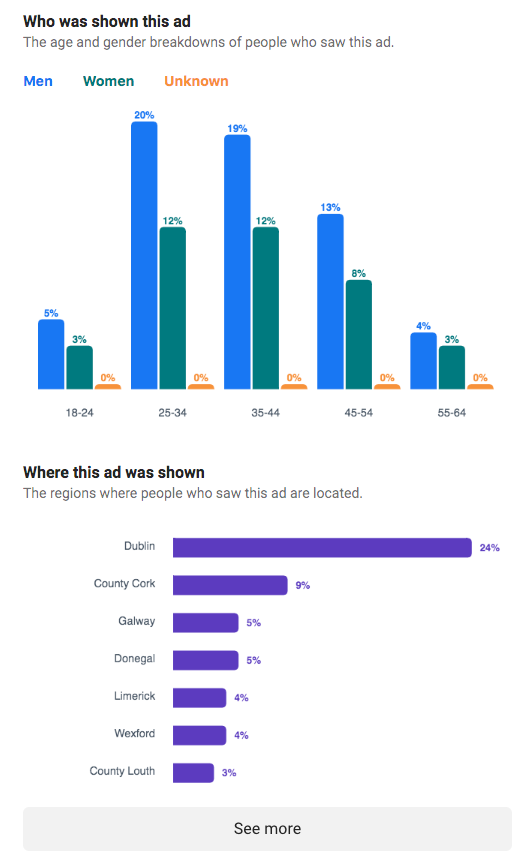
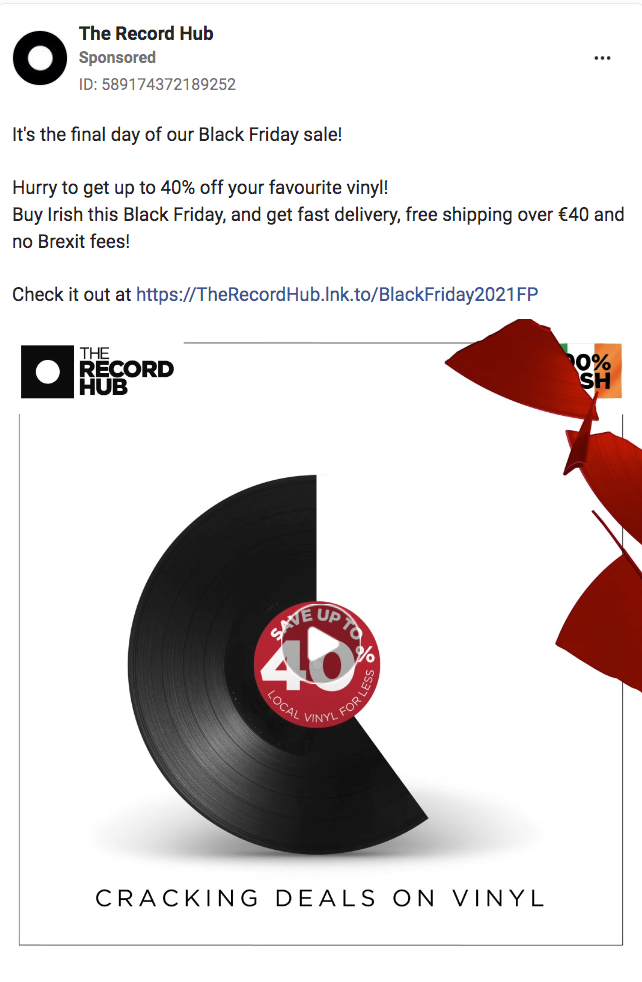
3. Cross-promote your offers
Black Friday is a great moment to cross-promote multiple products and offers via Facebook ads. Instead of only showing your audience one offer, why not maximize your efforts and display several items and offers?
With the start of the holiday season, consider being extra generous and giving your shoppers a free gift.
For example, FCTRY used the carousel ad format to cross-promote different products from their apparel line and offer a free action figure to shoppers.
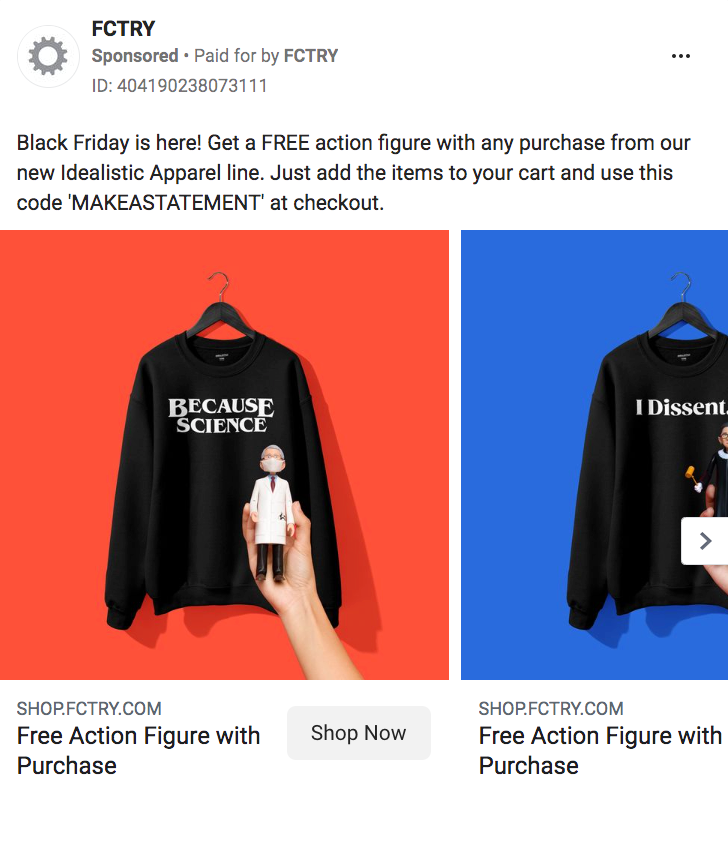
4. Optimize ad formats
In 2022, it was estimated that, for the first time, consumers would spend more than four in 10 retail ecommerce dollars on mobile. Increasing time spent on smartphones will trickle into shopping.
To tap into mobile shopping trends, brands should make their Black Friday Facebook ads mobile friendly. This means giving them a portrait orientation, providing large tappable buttons, and ensuring the text is large enough to be read on a small phone screen.
For example, apparel brand Crowned Free used a portrait video ad styled to suit mobile viewing.
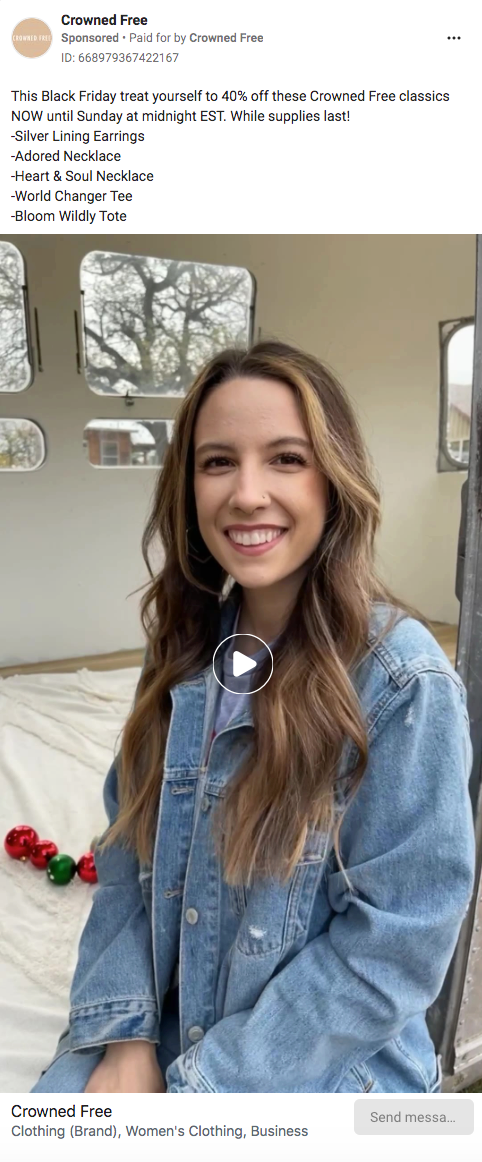
5. Avoid editing campaigns midway
Once you’ve set up your Black Friday campaign, avoid making any changes to it midway through. If you edit any part of the creative, the imagery or text, or if you change your audience targeting, the Facebook algorithm starts its learning phase about your ad all over again.
During your ad’s learning phase, Facebook makes modifications to the ad’s delivery to ensure it’s seen by the people most likely to convert. This learning phase can take up to 50 conversions and, depending on the ad, can take some time.
Although this wouldn’t harm your ad strategy during any other time of year, for Black Friday, you have such a limited window you don’t want to reset this learning phase.
To avoid changing your ads once they’re running, triple-check them before hitting publish. Make sure there are no typos, your image format and sizing are correct, and you haven’t included too much text in your images.
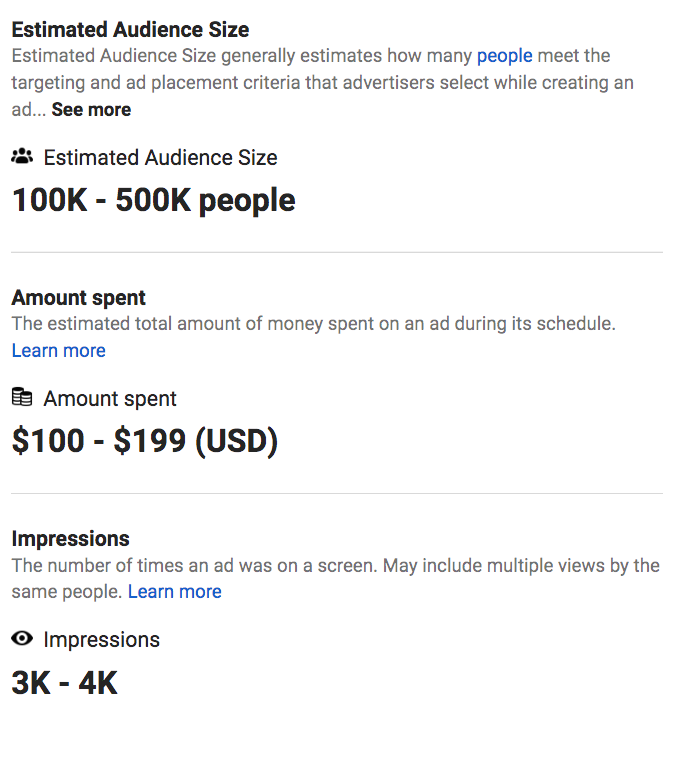
6. Review your spending limit
Since CPC usually rises during Black Friday, you’ll likely need a higher budget to see you through your campaign. Make sure you carefully budget your ads so you don’t run out of money halfway through your campaign and your ads are forced to stop.
Clothing brand CISE made sure to budget its ads wisely. Despite showing its ads to a narrow demographic of people, the brand was able to limit its Black Friday Ad spend to $199 for three days.
Since the brand was only running ads for several days, it successfully created a sense of urgency among consumers to shop with the brand before its bags sell out.
Common issues to avoid during Black Friday
Your Facebook advertising strategy needn’t be ultra-complex to get off the ground. But it’s important to nail a few basics before going all in with your campaigns.
1. Incomplete strategy
“Fail to prepare, prepare to fail,” goes the famous expression. With Black Friday Facebook ads, this couldn’t ring truer. Without a solid strategy, it’ll be hard, if not impossible, to give your ads the edge they need to stand out from the crowd.
An incomplete strategy may mean:
You run out of budget
You don’t target the right audience
The formatting of your ad creative is off
Taking the time to build a solid Black Friday Facebook ads strategy is key to boosting your conversion rate during the holiday period.
2. Wrong targeting
Targeting the wrong audience demographics will mean your ads won’t get in front of the right people who may actually convert. Your ad could feature witty copy, top-quality imagery, and look great on both mobile and desktop, but if it’s not targeted to the right audience it’s unlikely to have a high conversion rate.
Spend time defining your core target audience. How old are they? Where do they live? What profession do they have, and do they have specific hobbies? Once you know what your custom audience looks like, tailor your ads to it. Then, let Facebook create lookalike audiences to get your ads in front of more people who will likely show interest.
3. Only focusing on promotions and discounts
By only considering your BFCM promos you’re missing out on building genuine engagement with your audience. While your discounts should be the centerpiece of your campaign, consider how your ad sets can build brand awareness too. It’s important to use eye-catching imagery and on-brand copy so Facebook users can connect with your ads.
If your ad is only about your 40%-off promo, you run the risk of not engaging any of your target audience.
Create an effective Black Friday Facebook Ads campaign
Use these Black Friday Facebook ad examples to inspire your future marketing strategies. Before you create any Black Friday ads, make sure to define your target audience, budget, and promotions.
Then stick to your campaign setup and avoid making any changes halfway through. Always review your campaign’s metrics from last year to see what you can improve when running ads this time.
Black Friday Facebook Ads FAQ
1. Is $5 a day enough for Facebook ads?
$5 a day is enough to get started with Facebook ads. But the budget may not be enough during peak times of the year, like Black Friday and the festive season.
2. Do Facebook ads still work 2023?
Facebook ads are a more reliable way of reaching your target audience than organic reach. Brands can often only reach 3% of their followers organically. But with the ad system, brands can reach around 2.14 billion users.
3. Which Facebook ads are most effective in 2023?
According to Facebook, video ads are the most effective.
4. How often should I advertise on Facebook?
How often you should advertise on Facebook comes down to your brand’s goals and budget. You could frequently advertise to build brand awareness and get your products in front of more people. Or brands could advertise during the most important retail periods, like Black Friday and the festive season.
5. What are the best Facebook ads for Black Friday?
The best Facebook ads for Black Friday include:
Strong visuals and ad creatives
On-brand copywriting
Clear landing page
Accurate audience targeting
Black Friday Facebook Ad FAQ
How do I prepare for Black Friday ads on Facebook?
Decide what type of Black Friday ad you want to run on Facebook. Consider using ads that promote discounts, special offers, and limited-time deals.
Develop engaging content for your ad. Use visuals and compelling copy that will grab the attention of potential customers.
Set up a budget for your Black Friday ads. Consider how much you’re willing to spend on each ad and make sure you’re not overspending.
Target your audience. Make sure you’re targeting the right people for your Black Friday ads by creating an audience profile.
Test your ads. Before you launch your Black Friday ads, make sure you’ve tested them to ensure they’re performing as expected.
Monitor and optimize your ads. Keep an eye on your ads and make adjustments as needed to maximize your return on investment.
Should you run ads on Black Friday?
That depends on your business goals. If you're looking to generate more sales during the holiday season, running ads on Black Friday can be a smart decision. However, if you're looking to focus on brand awareness or are concerned about your budget, you may want to consider other strategies.
When should I start advertising for Black Friday?
It is recommended to start advertising for Black Friday at least two weeks before the event. This gives your customers plenty of time to plan their shopping and decide what they want to purchase. Additionally, it also gives you time to get your promotions and discounts in order, create ads, and optimize your website for the big day.
Read more
- Native Advertising for Ecommerce: From Content Discovery to Scaling Sales
- 5 Easy Tips For Getting Started With Conversion Rate Optimization
- 15 Conversion Rate Optimization Strategies from the Top Fashion Brands
- A Crisis Communications Plan for Brands
- 17 User-Generated Content Examples and 5 Tactics to Grow $15M+ in Annual Sales
- What Is Curbside Pickup (Click and Collect)?
- Hypefest 2018: O2O Examples from the Forefront of Marketing & Retail
- Is Your Agency 'The One'? An Inside Scoop on Finding a True Partnership
- Cash Flow Management Strategies
- Wholesale Ecommerce: What is It and How to Start?
